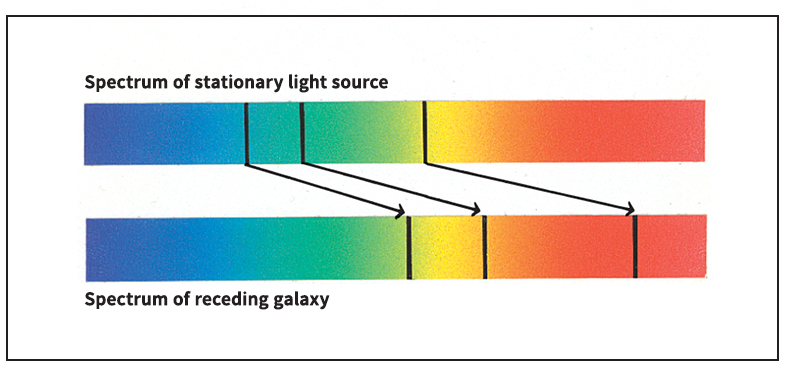Quasar, << KWAY sahr or KWAY zahr, >> is an extremely luminous object at the center of some distant galaxies. Quasars can resemble stars in our own galaxy in photographs. For this reason, they are sometimes called quasi-stellar (nearly starlike) objects. But they are actually among the most distant objects detected in the universe. The light from the farthest quasars traveled 13 billion light-years to reach Earth. A light-year is the distance light travels in a year, about 5.88 trillion miles (9.46 trillion kilometers). Some quasars shine a trillion times brighter than the sun. The word quasar is short for quasi-stellar radio source. Scientists applied this term to the first type of quasar identified.
Scientists determine the distance to a quasar by measuring the quasar’s redshift. Redshift is a shift in the wavelengths of light given off by an astronomical object. The light shifts toward the longer, or red, wavelengths of the spectrum. The more distant an object is, the larger its redshift. All quasars have large redshifts (see Redshift).

Quasars give off tremendous energy in the form of visible light, ultraviolet light, infrared rays, X rays, gamma rays, and in many cases, radio waves. They also release high-speed jets of positively charged particles called protons and negatively charged particles called electrons. Radiation from quasars takes billions of years to reach Earth. For this reason, the study of quasars can yield information about the early history of the universe.
Quasars were first identified in 1963 by a group of astronomers at the Palomar Observatory, near San Diego. Since then, astronomers have discovered thousands of quasars. They think each quasar is powered by a giant black hole at the center of a galaxy. A black hole is a region of space whose gravitational pull is so strong that nothing can escape it (see Black hole). The central black hole in a quasar produces energy by swallowing clouds of gas from the surrounding galaxy.
The mass (amount of matter) of the central black hole tends to be about 0.5 percent of the mass of all the stars in the surrounding bulge at the center of the quasar galaxy. Scientists use this relationship to try and determine how galaxies and their central black holes formed in the early universe. Most astronomers agree that the black holes were created after the universe’s first stars exploded in events called supernovae (see Supernova).
Loading the player...Centaurus A
Quasars rank as the most luminous objects in a more general category of galaxy centers called active galactic nuclei (AGN). Two less luminous types of AGN are blazars and Seyfert galaxies. However, many astronomers have proposed that the different types of AGN may not be different objects. This theory suggests that the observed differences between AGN are due to the angle from which astronomers on Earth see the objects. For example, a blazar may be an AGN with one jet pointing directly at Earth, while a Seyfert may be an AGN that is observed from the side of the jets.
See also Astronomy (Finding quasars).
